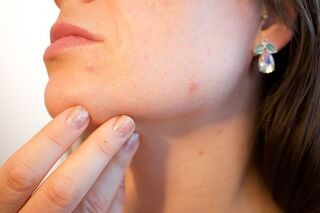Anxiety
Do You Pick at Your Skin? Here's How to Stop
Skin-picking, dermatillomania, is a relative of OCD.
Posted January 30, 2021 Reviewed by Matt Huston

Annie has been picking at her skin since she was in high school. When she is at work and stressed, her fingers automatically start exploring her face and neck, and if she feels a pimple, any rough or raised spot, she automatically starts to scratch at it. But she also has a ritual of sorts where she scans her overall body in the bathroom mirror before she goes to bed, and if she notices something, immediately attacks it. As a result of doing this for many years, she has visible external scars that she is self-conscious about. But she also has internal, psychological scars as well as a result of her feeling unable to stop it.
Annie’s problem is officially called dermatillomania, a condition related to obsessive-compulsive disorder (OCD), and it affects 1.4% of the population, about 75% of whom are female. And like OCD, with its compulsions – which can include compulsive hand-washing, checking stoves, or excessive cleaning or order – it follows a pattern of obsessing to compulsive behavior to anxiety relief: Having obsessive thoughts about a blemish; searching and scratching; feeling relief.
There are two reasons why this behavior is so difficult to break: One is that your hands and face are so closely in contact. When Annie sits down at her desk to work, and particularly if she is stressed and her hands are not occupied (like furiously typing), it’s easy for her fingers to drift to her face and neck. (The same happens for those who pull hair or bite nails.) Once within range, her hand and fingers go on autopilot, and she is often not even fully aware of what she is doing.
The second reason, which is true for OCD, is that her actions, despite being a disabling problem, "work" in the sense that her anxiety goes down. She has deeply rutted circuits in her brain that associate stress with her picking and her nightly ritual of scanning her body. Even before she enters the bathroom, her anxiety is likely already up. She looks in the mirror, sees a blemish and her anxiety goes even higher. She attacks the blemish by scratching or rubbing and it gets smaller, it feels or looks “different." As with the person who worries about germs and washes his hands five times, then automatically relaxes, the anxiety is reduced. Mission accomplished. The ritual temporarily solves the problem and, unfortunately, the pattern becomes further ingrained.
Breaking the pattern
As with most anxiety disorders and OCD disorders, the treatment path is three-fold:
1. Have a first-aid plan. The goal here is to stop the autopilot behavior. The key to this is being mindful and proactive. Here Annie needs to do a couple of things: Gauge her stress/anxiety level on a regular basis. If her anxiety and stress are already too high, it will be difficult for her to rein it in. This is where Annie wakes up in the morning and assesses herself: Am I feeling vulnerable because I didn’t sleep well, etc.? If yes, I need to be careful and mindful today.
Next, she needs to develop a plan to counter those high times – when she is at her desk, or at night in the bathroom. Here she tries to be aware of where her hands are at all times. She may decide to wear gloves or keep her fingernails short or put a Band-Aid over a blemish. And as soon she realizes she is starting to scratch or survey her skin, she needs to stop and take a break and do something behaviorally to lower her stress, such as deep breathing, taking a walk around the building, going to get a snack, talking to a colleague to break the pattern.
At night she needs to do the same: know what she is going to do differently before she goes into the bathroom, such as not look in the mirror (or cover it up) or only brush her teeth and walk out. Now if she successfully does this she needs to expect that her anxiety will ramp up. Why? Because she has broken the pattern and the circuits in her brain are going crazy. Here, she is going to pat herself on the back for doing a great job, for taking the risk, and do something that distracts her such as reading a good book or calling a friend.
2. Build anxiety management into the everyday. This is about treating the underlying disorder. Here Annie talks with a doctor about taking a medication such as an SSRI to reduce her overall anxiety level, or she increases exercise or does yoga or meditation. By having healthy routines that lower her anxiety threshold she is less vulnerable to being triggered.
3. Work on self-criticism and other patterns. Those prone to anxiety often tend to be self-critical, sometimes perfectionistic, tend to avoid confrontation with others, and instead accommodate and internalize their feelings. The larger goal is changing all of the above – pushing back against their critical voice, practicing lowering their expectations, learning to tolerate other’s strong emotions and speaking up, and being assertive rather than accommodating and collapsing. This takes work and dedication to these goals.
Next steps
- Explore therapy. Cognitive-behavioral therapy is an evidence-based treatment for OCD and related disorders. A good therapist can give you new ways of looking at your problems, help you change your self-talk, develop behavioral plans and teach stress-reduction tools, as well as helping you begin to tackle underlying challenges such as internalization and perfectionism.
- Consider medication. Many primary-care physicians are comfortable prescribing medications to help lower your overall anxiety level. If you are worried about becoming dependent on medications, think instead about using medication to jump-start the breaking of the OCD cycle. Often using them for a few months until the behavioral changes kick in can be exactly what you need.
- Get active. Therapy and meds are means to an end, ways of helping you reduce your overall anxiety/stress level, behaviorally breaking the brain circuits by proactively knowing your triggers and then plotting out and doing something different. But the starting point is intention – the desire to stop being a victim of your own habits – and action – taking concrete steps to change patterns and get the support you need to be successful.
Ready to start?




